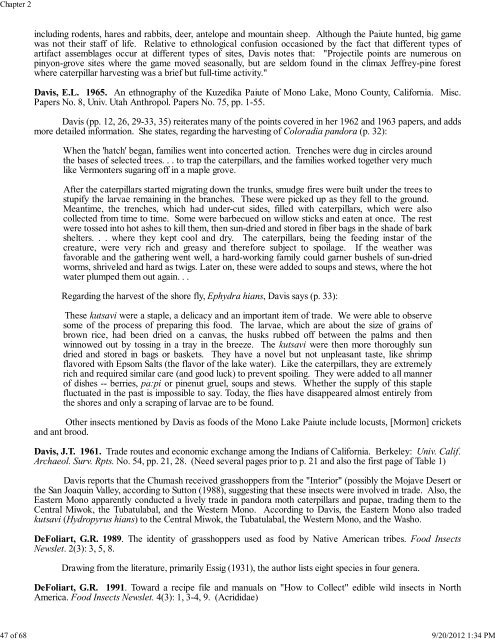Chapter 2. Insect Foods of North American Indigenous Populations ...
Chapter 2. Insect Foods of North American Indigenous Populations ...
Chapter 2. Insect Foods of North American Indigenous Populations ...
Create successful ePaper yourself
Turn your PDF publications into a flip-book with our unique Google optimized e-Paper software.
<strong>Chapter</strong> 247 <strong>of</strong> 68 9/20/2012 1:34 PMincluding rodents, hares and rabbits, deer, antelope and mountain sheep. Although the Paiute hunted, big gamewas not their staff <strong>of</strong> life. Relative to ethnological confusion occasioned by the fact that different types <strong>of</strong>artifact assemblages occur at different types <strong>of</strong> sites, Davis notes that: "Projectile points are numerous onpinyon-grove sites where the game moved seasonally, but are seldom found in the climax Jeffrey-pine forestwhere caterpillar harvesting was a brief but full-time activity."Davis, E.L. 1965. An ethnography <strong>of</strong> the Kuzedika Paiute <strong>of</strong> Mono Lake, Mono County, California. Misc.Papers No. 8, Univ. Utah Anthropol. Papers No. 75, pp. 1-55.Davis (pp. 12, 26, 29-33, 35) reiterates many <strong>of</strong> the points covered in her 1962 and 1963 papers, and addsmore detailed information. She states, regarding the harvesting <strong>of</strong> Coloradia pandora (p. 32):When the 'hatch' began, families went into concerted action. Trenches were dug in circles aroundthe bases <strong>of</strong> selected trees. . . to trap the caterpillars, and the families worked together very muchlike Vermonters sugaring <strong>of</strong>f in a maple grove.After the caterpillars started migrating down the trunks, smudge fires were built under the trees tostupify the larvae remaining in the branches. These were picked up as they fell to the ground.Meantime, the trenches, which had under-cut sides, filled with caterpillars, which were alsocollected from time to time. Some were barbecued on willow sticks and eaten at once. The restwere tossed into hot ashes to kill them, then sun-dried and stored in fiber bags in the shade <strong>of</strong> barkshelters. . . where they kept cool and dry. The caterpillars, being the feeding instar <strong>of</strong> thecreature, were very rich and greasy and therefore subject to spoilage. If the weather wasfavorable and the gathering went well, a hard-working family could garner bushels <strong>of</strong> sun-driedworms, shriveled and hard as twigs. Later on, these were added to soups and stews, where the hotwater plumped them out again. . .Regarding the harvest <strong>of</strong> the shore fly, Ephydra hians, Davis says (p. 33):These kutsavi were a staple, a delicacy and an important item <strong>of</strong> trade. We were able to observesome <strong>of</strong> the process <strong>of</strong> preparing this food. The larvae, which are about the size <strong>of</strong> grains <strong>of</strong>brown rice, had been dried on a canvas, the husks rubbed <strong>of</strong>f between the palms and thenwinnowed out by tossing in a tray in the breeze. The kutsavi were then more thoroughly sundried and stored in bags or baskets. They have a novel but not unpleasant taste, like shrimpflavored with Epsom Salts (the flavor <strong>of</strong> the lake water). Like the caterpillars, they are extremelyrich and required similar care (and good luck) to prevent spoiling. They were added to all manner<strong>of</strong> dishes -- berries, pa:pi or pinenut gruel, soups and stews. Whether the supply <strong>of</strong> this staplefluctuated in the past is impossible to say. Today, the flies have disappeared almost entirely fromthe shores and only a scraping <strong>of</strong> larvae are to be found.Other insects mentioned by Davis as foods <strong>of</strong> the Mono Lake Paiute include locusts, [Mormon] cricketsand ant brood.Davis, J.T. 1961. Trade routes and economic exchange among the Indians <strong>of</strong> California. Berkeley: Univ. Calif.Archaeol. Surv. Rpts. No. 54, pp. 21, 28. (Need several pages prior to p. 21 and also the first page <strong>of</strong> Table 1)Davis reports that the Chumash received grasshoppers from the "Interior" (possibly the Mojave Desert orthe San Joaquin Valley, according to Sutton (1988), suggesting that these insects were involved in trade. Also, theEastern Mono apparently conducted a lively trade in pandora moth caterpillars and pupae, trading them to theCentral Miwok, the Tubatulabal, and the Western Mono. According to Davis, the Eastern Mono also tradedkutsavi (Hydropyrus hians) to the Central Miwok, the Tubatulabal, the Western Mono, and the Washo.DeFoliart, G.R. 1989. The identity <strong>of</strong> grasshoppers used as food by Native <strong>American</strong> tribes. Food <strong>Insect</strong>sNewslet. 2(3): 3, 5, 8.Drawing from the literature, primarily Essig (1931), the author lists eight species in four genera.DeFoliart, G.R. 1991. Toward a recipe file and manuals on "How to Collect" edible wild insects in <strong>North</strong>America. Food <strong>Insect</strong>s Newslet. 4(3): 1, 3-4, 9. (Acrididae)
















